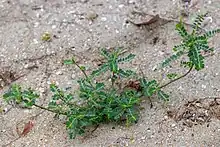Phyllanthus amarus
Phyllanthus amarus is a leafy herbal plant found in tropical regions in the Americas, Africa, India, China,Sri Lanka and South East Asia. Commons names for this plant include gale of the wind, carry me seed, seed on the leaf, pick-a-back,[1] Bhuiavla (Hindi), Bhuiamla (Bengali),[2] stonebreaker, dukung anak (Malay).[3]
| Phyllanthus amarus | |
|---|---|
 | |
| P. amarus from Thailand | |
| Scientific classification | |
| Kingdom: | Plantae |
| Clade: | Tracheophytes |
| Clade: | Angiosperms |
| Clade: | Eudicots |
| Clade: | Rosids |
| Order: | Malpighiales |
| Family: | Phyllanthaceae |
| Genus: | Phyllanthus |
| Species: | P. amarus |
| Binomial name | |
| Phyllanthus amarus | |
Description
P. amarus is a small, annual plant that grows to a height of 30-60 cm. Its thin branches spread out, and each branch has two rows of small, elliptic-oblong leaves of 5-10mm long that are arranged alternately.[3] Its radial flowers are star-shaped and of about 2mm in size.[4] It grows well in soil of high moisture with light shade, and reaches maturity in 2-3 months.
Constituents
P. amarus contains flavonoids (quercetin-3-0-glucoside and ruin), tannins (geraniin, amariin and gallocatechin) and alkaloids (phyllantine, quinolizidine type, securinine, norsecurinine, isobubbialine and epibubbialine).[3]
Uses
P. amarus has been used in the traditional medicine of various cultures, including Amazonian tribes for the treatment of gallstones and kidney stones; in Ayurvedic and සිංහල වෙදකම (Sinhala) medicine for bronchitis, anaemia, diabetes; and in Malay traditional medicine for diarrhoea, kidney ailments and gonorrhea.[3] More recently there have been preclinical and clinical studies looking into the plant's supposed liver-protective abilities[5][6] and effect on hepatitis B.[7]
According to animal tests, it has hepatic protection against paracetamol hepatoxicity in rats.[8]
 fruit
fruit flowers
flowers
References
- "Species page: Phyllanthus amarus". Atlas of Florida Plants. Retrieved 2021-04-15.
- Indian Herbal Pharmacopeia. Indian Drug Manufacturers' Association. 2002. p. 281.
- Samy, Joseph; Manickam, Sugumaran (2005). Herbs of Malaysia. Times Editions. pp. 184–185. ISBN 978-983-3001-79-8.
- "Phyllanthus amarus". National Parks Singapore. Retrieved 2021-04-15.
- Krithika, Rajesh; Verma, Ramtej; Shrivastav, Pranav; Suguna, Lonchin (2011). "Phyllanthin of Standardized Phyllanthus amarus Extract Attenuates Liver Oxidative Stress in Mice and Exerts Cytoprotective Activity on Human Hepatoma Cell Line". Journal of Clinical and Experimental Hepatology. 1 (2): 57–67. doi:10.1016/S0973-6883(11)60123-0. PMC 3940533. PMID 25755316.
- George, Annie; Udani, Jay; Yusof, Ashril (2019). "Effects of Phyllanthus amarus PHYLLPROTM leaves on hangover symptoms: a randomized, double-blind, placebo-controlled crossover study". Pharmaceutical Biology. 57 (1): 145–153. doi:10.1080/13880209.2019.1585460. PMC 6442116. PMID 30922154.
- Lee, C.D.; Ott, M.; Thyagrajan, S.P. (1996). "Phyllanthus amarus down‐regulates hepatitis B virus mRNA transcription and replication". European Journal of Clinical Investigation. 26 (12): 1069–1076. doi:10.1046/j.1365-2362.1996.410595.x. PMID 9013081. S2CID 43107866.
- Wongnawa, M.; Thaina, P.; Bumrungwong, N.; Nitiruangjarat, A.; Muso, A.; Prasartthong, V. (2005). "Effect of Phyllanthus amarus (Schum. & Thonn.) and its protective mechanism on paracetamol hepatotoxicity in rats". Acta Horticulturae. 680 (30): 195–201. doi:10.17660/ActaHortic.2005.680.30.